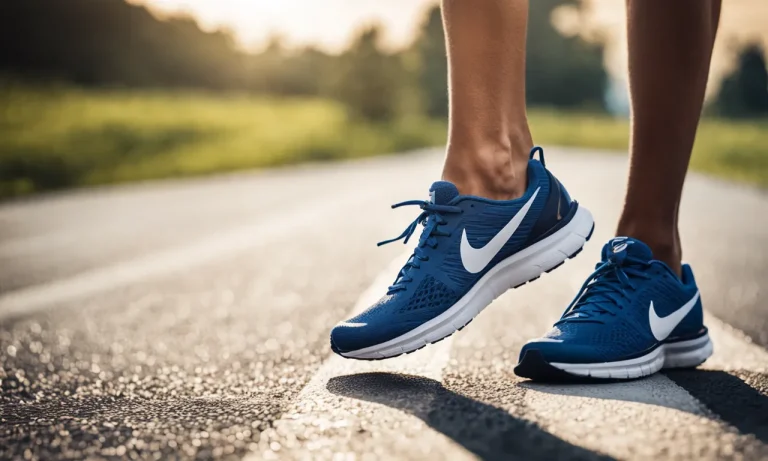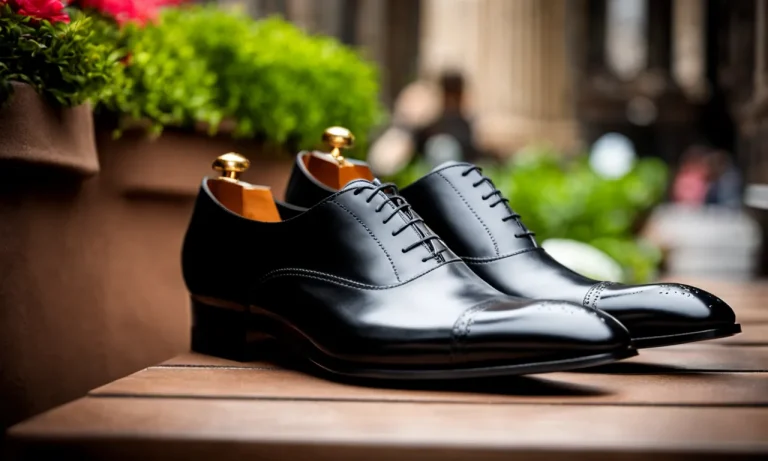For many of us, a good pair of leather boots is essential footwear. Sturdy, stylish, and built to last through years of wear, leather boots require some regular care and conditioning to stay in top shape.
If you’ve ever wondered what neatsfoot oil is and how to use it on your leather boots, you’ve come to the right place.
If you’re short on time, here’s a quick answer: Neatsfoot oil is an oil made from rendered cattle bones and fat that has been used for centuries to soften and condition leather boots and other leather goods. It helps moisturize leather, keeping it supple and preventing cracks.
Simply apply a small amount of oil evenly to clean, dry boots, let it soak in for up to 30 minutes, then wipe off any excess.
In this comprehensive guide, we’ll cover everything you need to know about using neatsfoot oil on boots, including: its history and origins, how it works, how to apply it properly, how often to use it, its benefits and drawbacks compared to other leather conditioners, and some helpful tips and precautions for getting the best results.
What is Neatsfoot Oil?
Neatsfoot oil is a type of animal-based oil that has been used for centuries to condition and preserve leather goods, particularly boots. It is derived from the shin bones and feet of cattle, hence the name “neatsfoot.”
This oil is highly regarded for its ability to penetrate deep into the leather, keeping it supple and preventing it from drying out and cracking over time.
History and Origins
The use of neatsfoot oil can be traced back to ancient civilizations such as the Egyptians and Romans, who recognized its benefits for leather preservation. It was commonly used by cowboys and horsemen in the American West to maintain their leather saddles, harnesses, and boots.
Over time, neatsfoot oil has become a staple in the leather care industry, cherished for its natural properties and effectiveness.
How It’s Made
To produce neatsfoot oil, the shin bones and feet of cattle are boiled down to extract the natural oils. The resulting mixture is then filtered to remove any impurities. Traditionally, neatsfoot oil was made from the feet of cattle, but nowadays, it is more commonly made from the shin bones due to animal welfare concerns.
The oil can be further refined or blended with other ingredients to create variations with specific properties.
Purpose and Uses
Neatsfoot oil is primarily used to condition and soften leather goods, including boots, shoes, saddles, belts, and baseball gloves. Its high absorption rate allows it to penetrate deep into the leather, restoring its natural oils and flexibility.
Additionally, neatsfoot oil helps to repel water, keeping leather items resistant to moisture damage. It can also be used to darken leather, making it an ideal choice for individuals looking to achieve a rich, aged patina on their boots or other leather accessories.
It is important to note that neatsfoot oil should only be used on full-grain or top-grain leather, as it may darken or stain lighter-colored leathers or suede. Additionally, it is recommended to apply the oil sparingly, as excessive use can lead to over-conditioning and possible damage to the leather.
For more information on neatsfoot oil and its uses, you can visit www.leathercareusa.com or www.heddels.com.
How Does Neatsfoot Oil Condition Leather?
Neatsfoot oil is a popular choice for conditioning leather due to its ability to nourish and protect the material. Here are the key ways in which neatsfoot oil benefits leather:
Softens and Moisturizes
Neatsfoot oil penetrates deep into the leather, softening it and restoring its natural suppleness. Leather can become stiff and dry over time, especially when exposed to harsh conditions. By applying neatsfoot oil, the oil seeps into the fibers, moisturizing them and revitalizing the leather.
This leaves your boots feeling comfortable and flexible, making them a pleasure to wear.
Prevents Cracking
One of the biggest enemies of leather is cracking. Leather that lacks moisture is prone to cracking, especially in areas that experience a lot of flexing and movement, such as the creases on boots. Neatsfoot oil helps prevent this issue by hydrating the leather and keeping it supple.
This reduces the chances of cracks forming, ensuring your boots stay in great condition for longer.
Protects Against Water
Leather is naturally porous, which means it can absorb water and become damaged if not properly protected. Neatsfoot oil acts as a barrier, repelling water and preventing it from seeping into the leather. This is especially important for boots that are frequently exposed to wet conditions.
By using neatsfoot oil, you can help shield your boots from water damage and extend their lifespan.
It’s important to note that neatsfoot oil can darken the color of leather, so it’s recommended to test it on a small, inconspicuous area before applying it all over. Additionally, it’s best to apply neatsfoot oil sparingly and in thin layers, allowing it to absorb into the leather gradually.
This will ensure the best results and prevent any excess oil from sitting on the surface.
If you’re unsure about how to properly use neatsfoot oil on your boots or have specific concerns about your leather, it’s always a good idea to consult a professional or reach out to the manufacturer for guidance.
How to Apply Neatsfoot Oil to Boots
Clean Boots First
Before applying neatsfoot oil to your boots, it is important to clean them thoroughly. Use a soft brush or cloth to remove any dirt or debris from the surface of the boots. You can also use a mild soap and water solution to gently scrub away any stains.
Let the boots dry completely before moving on to the next step.
Apply a Thin Coat of Oil
Once your boots are clean and dry, it’s time to apply the neatsfoot oil. Neatsfoot oil is a natural oil derived from the shinbones and feet of cattle. It is commonly used to condition and protect leather products.
Pour a small amount of neatsfoot oil onto a clean cloth or sponge, and then apply it to the boots in a thin, even layer. Make sure to cover the entire surface of the boots, including the seams and creases.
Let Oil Soak In and Wipe Away Excess
After applying the neatsfoot oil, allow it to soak into the leather for about 15-20 minutes. This will help the oil penetrate the leather and provide maximum conditioning. Once the oil has soaked in, take a clean cloth and gently wipe away any excess oil.
This step is important to prevent the boots from becoming too greasy or sticky.
It’s worth noting that neatsfoot oil may darken the color of some leather, so it’s a good idea to test it on a small, inconspicuous area of the boots before applying it to the entire surface. Additionally, it is recommended to avoid using neatsfoot oil on suede or nubuck leather, as it may cause discoloration or damage.
By following these steps, you can effectively apply neatsfoot oil to your boots and help extend their lifespan. Remember to regularly clean and condition your boots to keep them looking great and performing well.
How Often Should You Treat Boots with Neatsfoot Oil?
Neatsfoot oil is a popular choice for conditioning and preserving leather boots. It helps to keep the leather soft, supple, and resistant to water damage. However, it is important to know how often you should treat your boots with neatsfoot oil to ensure optimal results.
Factors to Consider
The frequency of neatsfoot oil treatment depends on various factors, including:
- The quality of the leather: Higher-quality leather may require less frequent treatment compared to lower-quality leather.
- The level of use: Boots that are regularly exposed to harsh conditions or heavy use may need more frequent oiling.
- The climate: Leather boots exposed to extreme temperatures or excessive moisture may require more frequent treatment.
It is essential to assess these factors to determine the appropriate schedule for treating your boots with neatsfoot oil.
General Guidelines
As a general rule of thumb, experts recommend treating your boots with neatsfoot oil every three to six months. This timeframe provides adequate protection and helps maintain the leather’s integrity. However, it is crucial to monitor the condition of your boots regularly.
If you notice any signs of dryness, cracking, or stiffness, it may be a signal that your boots need treatment sooner than the recommended timeframe. In such cases, don’t hesitate to apply neatsfoot oil to restore the leather’s moisture and flexibility.
Personal Preference and Observation
While following general guidelines is helpful, personal preference and observation play a significant role in determining the frequency of neatsfoot oil treatment. Some individuals prefer to treat their boots more frequently to maintain a glossy appearance, while others may choose to oil them less often to achieve a more worn-in look.
Observing your boots closely and understanding their specific needs will guide you in deciding the best interval for treating them with neatsfoot oil.
Remember, it is always better to err on the side of caution and provide your boots with regular maintenance to prolong their lifespan and keep them looking great.
For further information on leather care and maintenance, you can refer to reputable websites such as https://www.leatherworkinggroup.com/ or https://www.shoeshinekit.com/.
Benefits of Neatsfoot Oil vs. Other Conditioners
When it comes to conditioning your boots, neatsfoot oil offers several advantages over other types of conditioners. Let’s explore some of these benefits:
All Natural Ingredients
One of the key advantages of neatsfoot oil is its natural composition. Derived from the shin bones and feet of cattle, neatsfoot oil is a natural product that has been used for centuries to condition and preserve leather.
Unlike synthetic conditioners, neatsfoot oil does not contain any harmful chemicals that could potentially damage your boots or cause allergic reactions. Its natural properties make it a safe and effective choice for leather care.
Cheaper than Mink Oil or Leather Creams
Another benefit of neatsfoot oil is its affordability. Compared to other popular boot conditioners like mink oil or leather creams, neatsfoot oil is often more budget-friendly. This makes it a great option for those looking to maintain the quality and longevity of their boots without breaking the bank.
Whether you have a single pair of boots or a whole collection, neatsfoot oil offers a cost-effective solution for keeping your footwear in top shape.
Conditions Without Oversoftening
Neatsfoot oil is known for its ability to condition leather without oversoftening it. This is particularly important for boots, as you want them to maintain their shape and structure while still benefiting from the conditioning process.
Neatsfoot oil penetrates the leather, moisturizing it and preventing it from drying out, without compromising its natural firmness. This ensures that your boots remain comfortable, durable, and resistant to wear and tear.
Tips and Precautions for Using Neatsfoot Oil
Test on Small Hidden Area First
Before applying neatsfoot oil to your boots, it is important to test it on a small, hidden area first. This will allow you to see how the oil affects the leather and ensure that it doesn’t cause any unwanted discoloration or damage.
Apply a small amount of neatsfoot oil to an inconspicuous spot on your boots, such as the inside of the tongue or the back of the heel. Wait for a few hours and check for any adverse reactions. If there are no issues, you can proceed with treating the rest of your boots.
Avoid Using on Suede or Roughout Leather
Neatsfoot oil is primarily designed for use on smooth, full-grain leather. It may not be suitable for suede or roughout leather, as it can darken and potentially ruin the texture of these types of leather.
If you have suede or roughout boots, it’s best to use a specialized suede protector or cleaner instead. This will ensure that you maintain the original look and feel of your boots without risking any damage.
Store in Cool, Dry Place
When not in use, it’s important to store your neatsfoot oil in a cool, dry place. Exposure to extreme heat or moisture can cause the oil to deteriorate and lose its effectiveness. A cabinet or drawer away from direct sunlight and humidity is ideal for preserving the quality of the oil.
By storing it properly, you can ensure that it remains in good condition and ready to use whenever you need to condition your boots.
Rub in Well and Remove Excess
When applying neatsfoot oil to your boots, make sure to rub it in well with a clean cloth or brush. This helps the oil penetrate the leather and nourish it from within. However, it’s important not to overapply the oil, as this can lead to a greasy residue that can attract dirt and dust.
After applying the oil, take a clean cloth and gently remove any excess oil from the surface of the boots. This will leave your boots looking clean and well-conditioned, without any unwanted buildup.
Conclusion
With a long history and reputation as a versatile leather conditioner, neatsfoot oil remains a staple product for moisturizing and maintaining leather boots, shoes, jackets, baseball gloves, saddles, and more.
By penetrating deep into the leather fibers, it helps keep your boots supple and conditioned no matter how much wear you put them through.
The key is to apply it properly – with a light, thin coating rubbed in well and any excess wiped away. With regular but judicious use, neatsfoot oil can extend the life of your favorite boots while retaining their natural look and feel.
Don’t be afraid to rely on this classic leather conditioning oil handed down from past generations of boot wearers.






